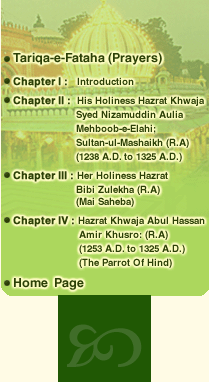(5) Writings
and Works:
Works of Khusro can be classified into
four categories–Diwan work, romantic work, historical work
and prose works. Khusro was well conversant in Arabic Persian
and Hindi. He was proud of it. He is also famous for many
verse-riddles, sayings, puzzles and ghazals. His Persian–Hindi
dictionary entitled Khalikbari is also a famous work.
He is considered a symbol of the integrated culture of India.
I. Diwans (Collection of ghazals,
lyrical poems, panegerics elegies, etc.)
- Tohfat-us-Sighar (Gift of Youth) poem written
between the 16th and 19th year of
his age. Compiled in 672 A.H./1272 A.D.
- Wasthul Hayath (Meridian of life): Poems written
between 19th and 24th year of his
age. compiled in 683 A.H./1283 A.D.
- Ghurrathul – Kamal (Prime of perfection):
The most important of the five Diwans containing poems
written between the 34th and 43rd
year of his age. compiled in 694 A.H./1294 A.D.
- Baqiya Naqiya (Remnants of Purity): Compiled
in his 64th year of his age in 716 A.H./1316
A.D
- Nihayatul Kamal (Pinacle of Perfection): The
last collection of poems compiled in 725 A.H./1325 A.D
II. Masnawis: The five
masnawis modelled on the Khamsa (five masnawis) of Ilyas
bin Yusuf Nizami Ganjavi (541 A.H./602 A.H./1114 A.D./1202
A.D.) and consisting of:
- Matlaul - Anwar (Dawn of lights) on ethics and
morals.
- Khusro - Shirin, a legendary love story.
- Majnun-o-Laila, also legendary love story.
- Aina-e-Sikandari (Mirror of Alexander) on events
in the life of Alexander the great.
- Hasht Behisth (Eight Paradises) Stories told
by Princesses with an introduction.
The first three of these Masnawis were
compiled in 699 A.H./1299 A.D. and the last two in 701 A.H./1301
A.D. and 702 A.H./1302 A.D. respectively.
III. Historical Masnawis:
- Qiran-us-Sadain (conjuction of two auspicious
stars) composed at the request of Moizuddin Kaiqabad (687
A.H./1287-690 A.H./1290 A.D.) After the poets return from
Awadh, the main theme being the encounter of kaiqabad
and his father, Bughra Khan, Governor of Lakhnawti their
meeting and final reconciliation. Compiled in 689 A.H./1289
A.D.
- Mifta-ul-Futuh (Key of victories): Describes
the four victories of Jalaluddin Firoze Khilji (690 A.H./1290
A.D.-695 A.H./1295 A.D) in of one year. Compiled in 691
A.H./1291 A.D
- Ashiqe (Duval Rani And Khizer Khan): Story of
love of Khizer Khan for Duval Rani and its tragic end,
completed in 715 A.H./1315 A.D. but with a chapter added
later.
- Nuh Sipehr (Nine Skies): Panegyrics to Mubarak
Shah Khilji (716 A.H./1316 A.D.-720 A.H./1320 A.D.) divided
into nine parts of unequal lengths, each called a sipehr,
and describing the buildings constructed by Mubarak Shah.
Compiled in 718 A.H./1318 A.D.
- Tughlaq Nama: Accounts of the victories of Ghiyasuddin
Tughlaq and a short history of his reign. Compiled in
725 A.H./1325 A.D.
IV. Prose Works:
- Khazainul-Futuh (Treasuries of Victories): Contains
s short history of reign of the Allauddin Khilji in which
the events that took place between 695 A.H./1295 A.D.
and 711 A.H./1311 A.D. are recorded. Compiled in 711 A.H./1311
A.D.
- Afzalul Fawaed (Greatest of Blessings): Containing
the teachings of His Holiness Hazrat Nizamuddin Aulia
(R.A.) (637 A.H./1237 A.D.-725 A.H./1325 A.D.) with dates
of his meetings with the master between 714 A.H./1314
A.D and 719 A.H./1319 A.D.
- Ejaz-e-Khusravi (Inspiration of Khusro): Containing
five manuals on the art of writing prose and poetry and
including some of his early letters to his friends. The
first four manuals were compiled in 683 A.H./1283 A.D.
and the last in 720 A.H./1320 A.D.
 —Chandogya
Upanishad (3.16.1).
—Chandogya
Upanishad (3.16.1).
- Life History
- A Great Scholar and Secular Poet
- Path of Sufism
- Son of an Indian Soil
- Writings and Works





